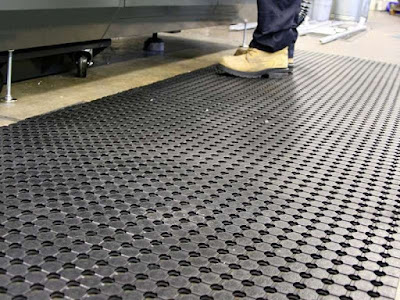Prolonged standing on hard surfaces can lead to discomfort, fatigue, and potential long-term health problems. Recognising the need for addressing these issues, more and more employers are installing anti-fatigue rubber mats. These game-changing products have become an important solution for workplaces and homes where long-standing activities are routine. These specialised mats represent more than just cushioned surfaces – they provide comfort and safety, enhancing employees’ well-being and productivity.
How Do Anti-Fatigue Rubber Mats Work?

With a combination of material qualities and ergonomic design principles, anti-fatigue rubber mats bring benefits by offering micro-movements in the leg muscles. When someone stands on a hard surface for too long, the muscles become somewhat static, which affects blood flow and increases fatigue. The rubber material in these mats adds a slight instability that facilitates minor movements in the leg muscles. These movements promote better circulation and reduce muscle fatigue.
Much of the effectiveness of these mats rests in their elasticity. When weight is applied, the rubber compresses and bounces back, providing a subtle but constant stimulus to the legs and feet. This redistribution of pressure across the foot and leg reduces the stress concentrated on pressure points. The surface of the mat also absorbs some of the impact forces, thereby further reducing physical stress.
Essential Features to Consider
How effective and durable the anti-fatigue rubber mats are, depends on several features. Firstly, consider the mat's thickness. Generally, 3/8 to 1-inch thick mats are best for cushioning the weight without presenting tripping hazards. A mat's density also comes into play, especially in terms of comfort and longevity. A soft mat, for example, may feel extra comfortable initially; however, super-soft matting may fail to provide enough support.
Surface texture is also important. Superior-quality rubber mats for sale have non-slip surface patterns that add stability while allowing easy movement. Look for mats that come with bevelled edges to prevent accidental tripping and allow for cart or wheelchair access. If used in wet areas, drainage holes or channels can prevent water accumulation and reduce slip hazards.
Industrial settings require resistance to environmental conditions. High-quality rubber mats need to be resistant to chemicals, oils, and temperature extremes without degradation. Some mats incorporate antimicrobial properties, which makes them suitable in medical settings or food service environments where hygiene is an utmost priority.
Benefits of Anti-Fatigue Mats
Anti-fatigue rubber mats provide a range of benefits that extend well beyond merely enhancing comfort. These mats can have a huge impact on worker productivity and well-being in the workplace. Some studies have indicated that employees using anti-fatigue mats reported less lower back pain and reduced fatigue by the end of their shifts. The increased comfort often translates to increased concentration and job satisfaction.
From the standpoint of safety, a rubber mat provides valuable slip resistance, especially relevant in places where spills are frequent. The mats may also cushion dropped items while providing noise reduction in working areas. In cooler environments, rubber mats can insulate feet from cold concrete floors and help keep work temperatures comfortable for a longer time.
These health benefits are possibly the most significant of all. Long-term use of anti-fatigue mats can prevent or reduce different types of musculoskeletal disorders. The improved posture will offset stress on the joints, lowering the likelihood of plantar fasciitis, varicose veins, or lower back issues. These aspects make anti-fatigue mats a great long-term investment in health and wellness.
Choosing the Correct Anti-Fatigue Mat

It is important to consider several factors when selecting the correct anti-fatigue mat. Assess the environment where the mat will be used. Different settings demand different features; a kitchen mat requires different properties compared to an industrial workstation mat. Factors such as exposure to chemicals and the temperature of the environment should also be taken into account.
Size and coverage area are another priority. The mat should be large enough to accommodate natural movements without causing the user to step on and off it frequently. For a workstation, the mat should extend slightly more than the stationary area to allow comfortable repositioning during the day.
Material quality and durability must match the expected use. Though higher-quality mats might cost more, they almost always offer an overall better value in longevity and performance. When you buy rubber mats, look for ones with warranties and certifications from reputable safety organizations, as this shows adherence to consistent quality standards.
Also, bear in mind the specific needs of the users. In areas where workers spend entire shifts standing, the investment in premium mats with advanced ergonomic features may be worthwhile. On the other hand, lighter-duty applications may call for plainer designs. The weight of the users and the kind of shoes they normally use will also play an active role in mat selection.
Finally, when looking for rubber mats for sale, factor in the maintenance requirements. Some mats require cleaning and almost daily upkeep to retain their properties, while others are more low maintenance. Go for a mat that fits into your maintenance schedule while meeting comfort and safety conditions for the workstation.
Takeaway
Anti-fatigue rubber mats are a significant advancement in workplace ergonomics and safer work environments. When you know how they work, what features to check for, and how to choose the right one, organisations can make steps towards providing comfort, safety, and long-term health benefits for those who spend a significant amount of time on their feet.